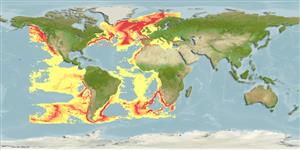Common names from other countries
Environment: milieu / climate zone / depth range / distribution range
Écologie
Récifal; profondeur 27 - 4312 m (Ref. 105406). Subtropical; 75°N - 58°S, 145°W - 36°E
Distribution
Pays | Zones FAO | Écosystèmes | Occurrences | Introductions
Eastern Pacific, Atlantic Ocean, Mediterranean Sea to the Arctic: Western to northern Europe, and Western Africa.
Length at first maturity / Taille / Poids / Âge
Maturity: Lm ? range ? - ? cm Max length : 2.0 cm SHH mâle / non sexé; (Ref. 90120)
Inhabits deep-water coral reef mound (Ref. 105183). It is also found in sublittoral to abyssal depths, usually attached to rocks, stones, gorgonians, or hydroids on muddy and sandy substrates (Ref. 90120). Epibionts on the trunk of the black coral Leiopathes glaberrima bush (Ref. 105183). Colonized by the parasitic foraminifer Hyrrokkin sarcophaga (Ref. 105186). Suspension feeder (Ref. 105183). In general, suspension feeding bivalves mainly depend on phytoplankton and detritus material for nutrition (Ref. 107088).
Life cycle and mating behavior
Maturité | Reproduction | Frai | Œufs | Fécondité | Larves
Members of the class Bivalvia are mostly gonochoric, some are protandric hermaphrodites. Life cycle: Embryos develop into free-swimming trocophore larvae, succeeded by the bivalve veliger, resembling a miniature clam.
Demir, M. 2003. (Ref. 2754)
Statut dans la liste rouge de l'IUCN (Ref. 130435)
statut CITES (Ref. 108899)
Not Evaluated
Not Evaluated
Utilisations par l'homme
| FishSource |
Outils
Plus d'informations
Taille/Âge
Croissance
Longueur-poids
Longueur-longueur
Morphologie
Larves
Abondance
Sources Internet
Estimates based on models
Preferred temperature
(Ref.
115969): 2.6 - 8.7, mean 4 (based on 528 cells).
